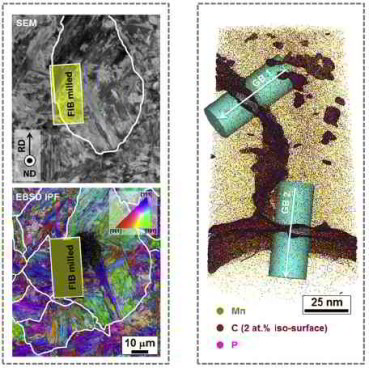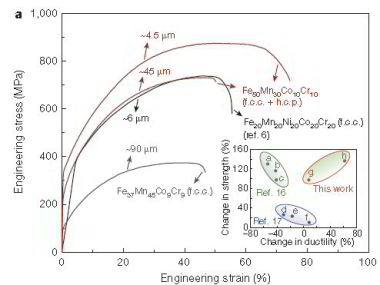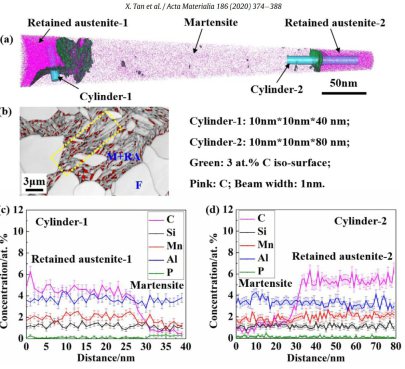Transformation Induced Plasticity Steels - TRIP steels
What is a TRIP effect ?
The TRIP effect is the particular formation of martensite induced by forming. Here, the stress-induced formation of martensite must be distinguished from the deformation-induced formation of martensite, since the TRIP effect only sets in with the latter. This causes a simultaneous increase in hardness and formability under plastic stress in product manufacture or use. The extent of the effect is mainly influenced by the inexpensive alloying elements carbon, manganese, aluminium and silicon.
The material's own yield strength is higher than that of comparable steels, as the added silicon allows solid solution hardening. As soon as the plastic range is reached during forming or deformation, the metastable carbon-rich austenite begins to transform into martensite induced by deformation. As a result, the TRIP steel is specifically hardened by the plastic deformation.
Microstructure of TRIP steels
The microstructure of Transformation-Induced Plasticity (TRIP) steels contains retained austenite embedded in a matrix of ferrite, bainite or martensite depending on alloy composition and preceding processing.
Also mixtures of these matrix compunds are frequently used.
TRIP steels are typically hypoeutectoid iron carbon alloys often with 0.1 – 0.4 mass% carbon.
The metastable austenite is typcially in the form of retained and partitioned austenite but reversed auistenite can be used too.
Typically TRIP steels contain 5-10 vol.% of metastable retained austenite or sometimes more.
Upon mechanical loading TRIP steels first undergo conventional dislocation plasticity of the soft ferrite portions of the microstructures and with further increase in deformation the retained austenite fraction progressively
transforms into martensite, thereby increasing the work hardening rate at higher strain levels.
What is spectral TRIP and how does it enable 1.1 GPa alloys?
Introduction of interlath reverted austenite is an effective method to design ductile lath martensitic steels. The challenge in this concept is that all reverted austenite films have similar
mechanical stability, hence, they all undergo transformation-induced plasticity (TRIP) at the same strain level. Here we
propose a new thermo-mechanical treatment route to activate the TRIP effect over a broad strain regime and refer to it as ‘spectral TRIP effect’. It aims at spreading the micro-mechanical
stability of reverted austenite grains by widening the austenite nucleation barrier in martensite. To validate the proposed
thermo-mechanical treatment route, an as-quenched medium-Mn martensitic steel was cold rolled prior to the reversion treatment at 600 C. Microstructure characterization was carried out by
electron backscatter diffraction (EBSD) and electron channeling contrast imaging (ECCI). Mechanical tests show that the approach is effective. The spectral TRIP effect improves both, the
strength and the ductility due to the well dispersed size distribution and the associated size-dependent deformation and phase transformation behavior of the reverted austenite grains,
extending TRIP-related work hardening over a broad strain range.
Acta Materialia 111 (2016) 262-272
Acta Materialia 111 (2016) 262 martensit[...]
PDF-Dokument [1.8 MB]
TRIP effect in Medium-Manganese Steels
In this project the effects of prior austenite (gamma) grain boundaries and microstructural morphology on the impact toughness of an annealed Fe-7Mn-0.1C-0.5Si medium Mn steel were investigated
for two different microstructure states, namely, hot-rolled and annealed (HRA) specimens and cold-rolled and annealed (CRA) specimens. Both types of specimens had a dual-phase microstructure
consisting of retained austenite (gamma-R) and ferrite (a) after intercritical annealing at 640°C for 30 min. The phase fractions and the chemical composition of retained austenite were almost
identical in both types of specimens. However, their microstructural morphology was different. The HRA specimens had lath-shaped morphology and the CRA specimens had globular-shaped morphology. We
find that both types of specimens showed transition in fracture mode from ductile and partly quasi-cleavage fracture to intergranular fracture with decreasing
impact test temperature from room temperature to 196°C. The HRA specimen had higher ductile to brittle transition temperature and lower low-temperature impact toughness compared to the CRA specimen.
This was due to intergranular cracking in the HRA specimens along prior gamma grain boundaries decorated by C, Mn and P. In the CRA specimen intergranular cracking occurred along the boundaries of
the very fine a and a' martensite grains. The results reveal that cold working prior to intercritical annealing promotes the elimination of the solute-decorated boundaries of coarse prior gamma
grains through the recrystallization of aʹ martensite prior to reverse transformation, hence improving the lowtemperature impact toughness of medium Mn steel.
Acta Materialia 122 (2017) 199-206
Fe Acta 2016 Han Medium Mn Steel prior a[...]
PDF-Dokument [3.8 MB]
How can we design TRIP steels with core-shell microstructures?
The mechanical performance of multi-phase steel microstructures critically depends on the constituents’ chemical and morphological constitutions, which in combination determine the composite
hardness, the onset of plasticity, internal load and strain-partitioning, as well as the stability and transformation kinetics
of retained austenite in case of TRIP steels. The novel approach of utilising temporary vessel phases, hence termed vessel microstructure design, enables the tuning of constituent phase
properties by linking their formation to a controllable landscape of chemical gradients. This approach hinges on the
introduction of alloy carbides as a temporary container, or ‘vessel’ phase, deliberately producing localised enrichment of alloying elements in a structure predetermined by preliminary heat
treatments, referred to as conditioning and accumulation stages. These vessel carbides, which act as reservoirs for specific
alloying elements, are then partially dissolved through flash heating, leading to a self-organising landscape of alloying elements in the vicinity of the dissolving particles. The resulting
three- or multiple phase microstructures then consist of confined laminates incorporating retained carbides, enveloped by retained austenite shells, embedded within a martensitic matrix.
Such complex yet entirely self-organized microstructures offer unique opportunities for strain and load partitioning which we refer to as core-shell micromechanics. Different variants of
these core-shell composite structures are produced and examined together with reference microstructures by tensile testing, hardness mappings, impact toughness, X-ray measurements, as well
as by electron microscopy. It is found that these novel microstructures, when tempered, exhibit ultra-high strength and delayed necking, enabled by a combination of gradual strain-hardening
and transformation-induced plasticity that is tuneable via control of the
initial carbide structure.
Acta Materialia 113 (2016) 19-31
Belde Acta Materialia vol 113 (2016) pag[...]
PDF-Dokument [1.5 MB]
Which crystallographic orientation relationships matter during transformation of austenite to bainite in TRIP steels?
The crystallographic orientation relationships that are active during the transformation of austenite to bainite are studied for two TRIP steels by means of Electron BackScatter Diffraction
(EBSD). A detailed evaluation of about 360 retained austenite grains and their BCC neighbours was performed. Three relationships were considered, namely Kurdjumov–Sachs,
Nishiyama–Wassermann and Pitsch. It was found that the majority of the austenite grains had at least one neighbour that could be related with one of the three orientation
relationships. The Kurdjumov–Sachs relationship appeared to be dominant and no strong indication for variant selection could be retrieved from the studied data. It was, however, also
demonstrated that some precautions need to be made since a clear distinction between the evaluation of a small region of the microstructure and conclusions made for the complete material is
necessary.
ISIJ International, Vol. 49 (2009), No. 10, pp. 1601–1609
ISIJ International 49 (2009) 1601.pdf
PDF-Dokument [1.1 MB]
Transformation-induced plasticity–twinning-induced plasticity steel with high damage resistance
Conventional martensitic steels have limited ductility due to insufficient microstructural strain-hardening and damage resistance mechanisms.
It was recently demonstrated that the ductility and toughness of martensitic steels can be improved without sacrificing the strength, via partial reversion of the martensite back to austenite.
These improvements were attributed to the presence of the transformation-induced plasticity (TRIP) effect of the austenite phase, and the precipitation hardening (maraging) effect in the
martensitic matrix. However, a full micromechanical understanding of this ductilizing effect requires a systematic investigation of the interplay between the two phases, with regards to the
underlying deformation and damage micromechanisms. For this purpose, in this work, a Fe–9Mn–3Ni–1.4Al–0.01C (mass%) medium-Mn TRIP maraging steel is produced and heat-treated under
different reversion conditions to introduce well-controlled variations in the austenite–martensite nanolaminate
microstructure. Uniaxial tension and impact tests are carried out and the microstructure is characterized using scanning and transmission electron
microscopy based techniques and post mortem synchrotron X-ray diffraction analysis. The results reveal that (i) the strain partitioning between austenite
and martensite is governed by a highly dynamical interplay of dislocation slip, deformation-induced phase transformation (i.e. causing the TRIP effect) and mechanical twinning (i.e. causing the
twinning-induced plasticity effect); and (ii) the nanolaminate microstructure morphology leads to enhanced damage resistance. The presence of both effects results in enhanced strain-hardening
capacity and damage resistance, and hence the enhanced ductility.
Acta Materialia 85 (2015) 216-228
Acta Materialia 85 (2015) 216 Wang et al[...]
PDF-Dokument [3.8 MB]
How to model twinning- and transformation-induced plasticity? A crystal plasticity approach.
Here a dislocation density-based crystal plasticity model incorporating both transformation-induced plasticity (TRIP) and twinning-induced plasticity (TWIP) is presented. The approach is a physically-based model which reflects microstructure investigations of ε-martensite, twins and dislocation structures in high manganese steels. Validation of the model was conducted using experimental data for a TRIP/TWIP Fe- 22Mn-0.6C steel. The model is able to predict, based on the difference in the stacking fault energies, the activation of TRIP and/or TWIP deformation mechanisms at different temperatures.
A crystal plasticity model for twinning- and transformation-induced plasticity
Acta Materialia 118 (2016) 140-151
crystal plasticity twinning and TRIP Act[...]
PDF-Dokument [1.5 MB]
Is there a size effect in TRIP steels ?
Steels containing reverted nanoscale austenite islands or films dispersed in a martensitic matrix show excellent strength, ductility and toughness. The underlying microstructural mechanisms
responsible for these improvements are not yet understood, but are observed to be strongly connected to the island or film size. Two main micromechanical effects are conceivable in this context,
namely: (i) interaction of gamma with microcracks from the matrix (crack blunting or arresting); and (ii) deformation-induced phase transformation of gamma to martensite (TRIP effect).
The focus here is on the latter phenomenon. To investigate size effects on gamma transformation independent of other factors that can influence austenite stability (composition,
crystallographic orientation, defect density, surrounding phase, etc.), a model (TRIP-maraging steel) microstructure is designed with support from diffusion simulations (using
DICTRA software) to have the same, homogeneous chemical composition in all gamma grains. Characterization is conducted by in-situ tension and bending experiments in conjunction with
high-resolution electron backscatter diffraction mapping and scanning electron microscopy imaging, as well as post-mortem transmission electron microscopy and synchrotron X-ray diffraction
analysis. Results reveal an unexpected “smaller is less stable” effect due to the size-dependent competition between mechanical twinning and deformation-induced
phase transformation.
Acta Materialia 79 (2014) 268-281
Wang et al Acta Materialia 79 (2014) 268[...]
PDF-Dokument [1.2 MB]
How to combine the TRIP effect with the maraging effect in one alloy class: TRIP-maraging steels
We present mechanical and microstructure results on precipitation-hardened ductile high-strength martensitic and austenitic–martensitic steels (up to 1.5 GPa strength) with good ductility. The alloys have a low-carbon content (0.01 wt.% C), 9–12 wt.% Mn, and minor additions of Ni, Ti and Mo (1–2 wt.%). Hardening is based on transformation-induced plasticity and the formation of intermetallic nanoprecipitates in the martensite during heat treatment (aging). The approach leads to an unexpected simultaneous increase in both strength and total elongation.
Scripta Materialia 60 (2009) 1141–1144
Scripta Materialia 60 (2009) 1141 maragi[...]
PDF-Dokument [342.1 KB]
Can High Entropy Alloys have a TRIP effect?
In this project we developed a metastability-engineering strategy for the design of nanostructured, bulk high-entropy alloys with multiple compositionally equivalent high-entropy phases.
High-entropy alloys were originally proposed to benefit from phase stabilization through entropy maximization. Yet here, motivated by recent work that relaxes the strict
restrictions on high-entropy alloy compositions by demonstrating the weakness of this connection, the concept is overturned. We decrease phase stability to achieve two key benefits:
interface hardening due to a dual-phase microstructure (resulting from reduced thermal
stability of the high-temperature phase); and transformation-induced hardening (resulting from the reduced mechanical stability of the room-temperature phase). This combines the best of
two worlds: extensive hardening due to the decreased phase stability known from advanced steels and massive solid-solution
strengthening of high-entropy alloys3. In our transformation-induced plasticity-assisted, dual-phase high-entropy alloy (TRIP DP- HEA), these two contributions lead respectively to
enhanced trans-grain and inter-grain slip resistance, and hence, increased strength. Moreover, the increased strain hardening capacity
that is enabled by dislocation hardening of the stable phase and transformation-induced hardening of the metastable phase produces increased ductility.
9 June 2016, Vol 534, Nature p. 227
Li et al Nature June 2016 Metastable hig[...]
PDF-Dokument [6.0 MB]
How is the interplay of strain partitioning and chemcial partitioning in TRIP steel?
For studying the interplay of micromechanics and local composition partitioning among the neighboring phases we applied two types of hot-rolling direct quenching and partitioning (HDQ&P)
schemes to a low-C low-Si Al-added steel and obtained two ferrite-containing TRIP-assisted steels with different hard matrix structures, viz, martensite or bainite. Using quasi in-situ tensile
tests combined with high-resolution electron back-scattered diffraction (EBSD) and microscopic digital image correlation (m-DIC) analysis, we quantitatively investi-
gated the TRIP effect and strain partitioning in the two steels and explored the influence of the strain partitioning between the soft and hard matrix structures on the TRIP effect. We also
performed an atomic-scale analysis of the carbon partitioning among the different phases using
atom probe tomography (APT).
The results show that the strain mainly localizes in the ferrite in both types of materials. For the steel with a martensitic hard-matrix, a strong strain contrast exists between ferrite and
martensite, with the local strain difference reaching up to about 75% at a global strain of 12.5%. Strain localization bands initiated in the
ferrite rarely cross the ferrite/martensite interfaces. The low local strain (2%-10%) in the martensite regions leads to a slight TRIP effect with a transformation ratio of the retained
austenite of about 7.5%. However, for the steel with bainitic matrix, the ferrite and bainite undergo more homogeneous strain partitioning, with an average local strain in ferrite and
bainite of 15% and 8%, respectively, at a global strain of 12.5%. The strain localization
bands originating in the ferrite can cross the ferrite/bainite (F/B) interfaces and increase the local strain in the bainite regions, resulting in an efficient TRIP effect. In that case the
transformation ratio of the retained austenite is about 41%. The lower hardness difference between the ferrite and bainite of about 178 HV, compared with that between the ferrite and martensite
of about 256 HV, leads to a lower strain contrast at the ferrite/bainite interfaces, thus retarding interfacial fracture. Further microstructure design for TRIP effect optimization should
particularly focus on adjusting the strength contrast among the matrix structures and tuning strain partitioning to enhance the local strain
partitioning into the retained austenite.
Tan et al Acta Materialia 2020 strain pa[...]
PDF-Dokument [1.5 MB]





